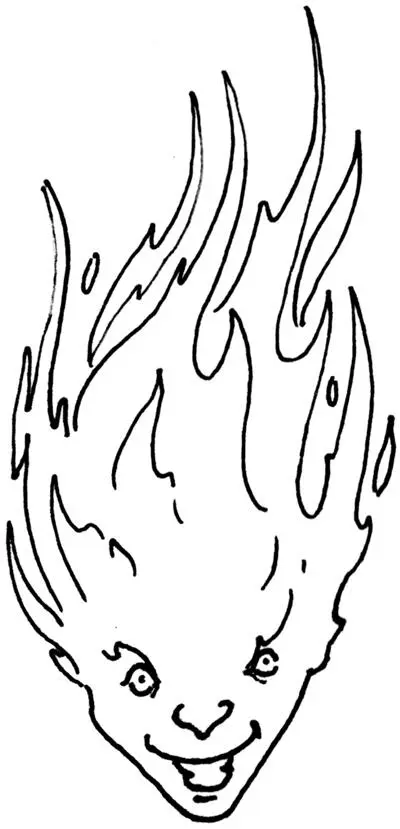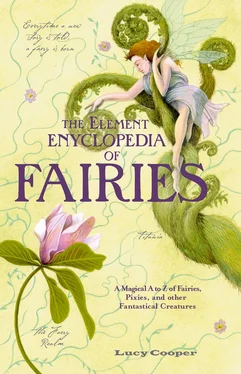A Lancashire nursery spirit similar to Wee Willie Winkie, who sprinkles magic dust or sand into the eyes of children to get them to sleep. In the 1908 novel The Blue Lagoon: A Romance by H. de Vere Stacpoole, Billy Winker is invoked as a similar figure to the Sandman: “‘Shut your eyes tight … or Billy Winker will be dridgin’ sand in them.’”
However, in a traditional folk song from Lancashire in John Trafford Clegg’s Sketches and Rhymes in the Rochdale Dialect (1895), Billy Winker is a drayman a little too fond of drinking the contents of the barrels of ale he delivers.
(Also eloko .) Malevolent dwarvesin the folklore of the Nkundo people of central Zaire. Bilokos used bells to bewitch humans, placing spells upon them that could result in death. These malignant creatures dwelled in hollow trees and subsisted on a diet of human flesh. They are described as having beards of grass and wearing garments of leaves.
In one tale a wife stays behind at the hut while her husband goes hunting. As he leaves, he warns her that if she hears the ringing of a bell she must pay no attention to it, for it portends death. However, later that day, when the woman is alone in the silence of the forest, she is charmed to hear the ringing of a little bell and invites the owner of the bell to join her at the hut.
A biloko dwarf emerges from the forest and joins the woman. She offers him some food cooked over her fire, but he tells her he eats only human flesh. By now the woman is under his spell and she offers him the flesh of her arm.
The next day, the bell rings again and this time the bewitched woman offers the biloko the flesh of her buttocks.
On the third day, suspecting some evil is afoot, the husband does not go hunting, but instead hides behind the hut. When the dwarf appears and holds a knife to the woman’s side, proclaiming he wants to eat her liver, the man fires an arrow at him.
Struck by the blow, the biloko falls down, driving his knife into the woman’s side, and killing her.
The husband drives his spear into him and beheads him, then invites the people from the village to see the vanquished dwarf.
A Somalian folk tale recounts the battle of two giantswho each ruled half of the country. Habbad was cruel and wicked, but the benevolent giant Biriir ina Barqo came to hear of his despotic ways and defeated the oppressor in a battle, thus uniting the country under his peaceful rule.
Nature spirits associated with waterfalls, pools, and also rocky outcrops, who are described in traditional Central African folk legends. They take on diverse names and attributes in other areas of the continent. Generally benevolent toward humans, they can be troublesome if generous offerings are not forthcoming and downright malevolent in their attempts to penetrate the brains of children. Mothers have devised a simple foil to this endeavor by placing a wooden sliver across the fontanelle on their babies’ heads.
A poem by Leicestershire poet John Heyrick, who lived in the eighteenth century, describes Black Annis thus:
Tis said the soul of mortal man recoil’d,
To view Black Annis’ eye, so fierce and wild;
Vast talons, foul with human flesh, there grew
In place of hands, and features livid blue
Glar’d in her visage; while the obscene waist
Warm skins of human victims close embraced.
This flesh-eating, blue-faced hag lived in a cave in the Dane Hills near Leicester. She was supposed to have excavated it with her bare hands, using only her long, clawlike iron nails. She was partial to a diet of children and lambs, and when she had devoured them, their skins were spread over the branches of the giant oak tree at the mouth of the cave.
See Barguest , Capelthwaite , Cù Sith , Cwn Annwn , Yeth Hound .
Literally, “Flower Face,” taking her name from the Welsh blodeu , “flower” or “blossom,” and gwedd , “face” or “appearance,” Blodeuedd is one of the main female figures in the fourth branch of the Mabinogion , a collection of ancient epic Welsh stories, which relates how she was made from oak, broom, and meadowsweet as a magical bride for Lleu Llaw Gyffes, “Lleu the Fair of the Steady Hand,” son of Arianhod.
See Rawhead and Bloody Bones .
A malevolent fairy in Slavic mythology who causes confusion and disorientation.
A folk tale from Somerset describes the pranks of Blue Burches (breeches), a hobgoblinof a mischievous but harmless disposition whose tricks were endured with forbearance by the cobbler in whose house he lived. In time, the local clergymen heard of the hobgoblin and came to the conclusion he was an incarnation of the Devil, whereupon they set out to exorcise him. The cobbler’s son unwittingly betrayed Blue Burches in the guise of an old white horse grazing nearby and the parsons cried out, “Depart from me, you wicked—!” The hobgoblin dived into the duck pond and was gone.

A spirit of the mines in the north of England, manifesting as a small, flickering blue flame. The diligent blue-caps expected and received their modest wages in a far-flung corner of the mine and were helpful to respectful miners, warning them of prospective dangers.
See also Coblynau , Knockers , Kobold .
“The Blue Men of the Minch,” a tale relating particularly to that stretch of water in the Hebrides between Lewis and the Shiant Islands, is related in J. G. Campbell’s Superstitions of the Highlands and Islands of Scotland (1900), in which an eyewitness “who was very positive he had himself seen a one” describes his encounter: “A blue-coloured man with a long grey face and floating from the waist out of the water, followed the boat he was in for a long time, and was occasionally so near that the observer might have put his hand upon him.”
The Blue Men were held responsible for the stormy waters of the Minch, leaving their undersea cave-dwellings to swim toward passing ships to wreck them and only being thwarted in their intent by canny captains who could outwit them with rhyme and a sharp tongue. They are variously described as fallen angels or, as in D. A. Mackenzie’s Scottish Folk-lore and Folk Life (1935), as being based on historical accounts of captured Moors in Ireland, called “Blue Men,” who were abandoned in the ninth century by Norse seafarers.
Literally, “old man” or “specter,” this name is found in numerous place names in Scotland. Tigh nam Bodach or “House of the Specter,” is an example of an ancient pagan site in a remote glen, where a “family” of curiously shaped stones bears the names of the Bodach , his wife Cailleach , and their children. These supernatural beings, as folk tales relate, were responsible for the fertility of the area and, being treated kindly by the local population, left the stones to be moved out of the shelter each year during the summer to ensure continuing abundance.
Читать дальше













